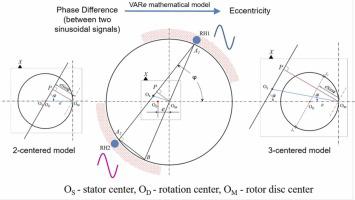Sensors and Actuators A: Physical ( IF 4.1 ) Pub Date : 2022-07-26 , DOI: 10.1016/j.sna.2022.113774 Gaurav Behrani , Abhilash Mony , N. Gireesh Sharma

|
High precision optical angular sensors are extensively used for detection and control of position and velocity in payload rotating mechanisms and spacecraft actuators. The accuracy and thus the performance of the encoder are significantly affected due to installation eccentricity. In this paper, a comprehensive study of the causes of installation eccentricity is done. The apportionment of the resultant eccentricity is attributed to variations in diametrical clearances, doweling error, gluing error of the glass disc and bearing wobble. The effect of eccentricity changes during rotation. A new 3-center variable eccentricity model is introduced which improves upon the existing 2-centered one in previous literature. This new 3-centered model is able to better predict the deviations in the fine angle signals in a practical system due to variable eccentricity effect. The efficacy of the mathematical model was validated through two independent experiments- 1) by analyzing the electrical signals from opposite read-heads and 2) by performing mechanical measurements- both done on an actual sensor assembly. The eccentricity value calculated from the maximum and minimum phase difference of the fine angle signals is able to exactly match with the total phase difference variation over one complete rotation. It is observed that the variation in the phase difference between the fine angle sinusoidal signals given by two opposite read-heads varies as a shifted sine over one complete rotation and not as a symmetric sine as shown in previous literature. The eccentricity value obtained from mechanical measurement and that computed using the 3-centered model was matching within 0.1 µm. Both the experimental results support the effectiveness of the 3-centered model.
中文翻译:

高精度角度传感器精细角度信号中偏心效应的建模与验证
高精度光学角度传感器广泛用于检测和控制有效载荷旋转机构和航天器执行器中的位置和速度。安装偏心会显着影响编码器的精度和性能。本文对安装偏心的原因进行了综合研究。产生的偏心度的分配归因于直径间隙的变化、销钉误差、玻璃盘的粘合误差和轴承摆动。偏心度的影响在旋转过程中会发生变化。引入了一种新的 3 中心变量偏心率模型,该模型改进了先前文献中现有的 2 中心模型。由于可变偏心效应,这种新的 3 中心模型能够更好地预测实际系统中精细角度信号的偏差。数学模型的有效性通过两个独立的实验得到验证——1)通过分析来自相对读取头的电信号和 2)通过执行机械测量——均在实际传感器组件上完成。从精细角度信号的最大和最小相位差计算的偏心率值能够与一整圈的总相位差变化量完全匹配。可以观察到,由两个相对的读取头给出的细角正弦信号之间的相位差变化在一个完整的旋转过程中作为偏移的正弦变化,而不是如先前文献中所示的对称正弦变化。通过机械测量获得的偏心率值与使用 3 中心模型计算的偏心率值匹配在 0.1 µm 以内。两个实验结果都支持三中心模型的有效性。











































 京公网安备 11010802027423号
京公网安备 11010802027423号